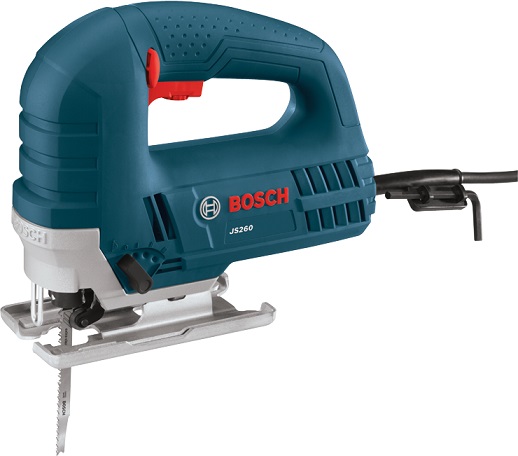A Jigsaw is a very versatile power tool that can make precision cuts in a variety of materials. While the main use case of a Jigsaw is to cut curves, we can also use it to cut lumber, make holes in plastic or plywood, or even create complex shapes out of different materials. In this beginner’s guide, we will take a look at the basics of Jigsaw. After that, we will see the best applications of a Jigsaw. Finally, we will take a look at different types of jigsaws.
We already covered a great deal about the best Jigsaws you can buy, Jigsaw Safety, and even a comparison between Reciprocating Saw vs Jigsaw. Check those guides for more info on Jigsaws.
Outline
ToggleWhat is a Jigsaw?
If you are familiar with a Bandsaw, then the operation of a Jigsaw seems very similar. While a bandsaw is a large tool with a continuous steel band to make precise curve cuts, a Jigsaw is a handheld tool with a thin blade that makes reciprocating movements.
Using the up-and-down motion of the vertical blade in a Jigsaw, you can easily make curved cuts and diagonal cuts. Even a novice in power tools can easily use a Jigsaw. This can be a good beginner tool instead of those big and bulky power tools such as a bandsaw or a table saw.
The primary material that you can use the Jigsaw on is wood. Although, you can make cuts in other materials such as metal, plastic, tiles, etc.
Applications of Jigsaw
The main application of a Jigsaw is to make curved cuts in wood. This is very useful in making furniture, art, or other creative designs. Apart from wood, you can also use Jigsaws on plastic, metal (sheets), tiles, etc.
Due to its thin vertical blade and easy handheld implementation, you can use Jigsaw in small or tight spaces, following the design or curved line.
Jigsaws are also not heavy tools. They weigh very less and hence it becomes very easy to guide them on any complex path.
You can cut very accurate circles of any size using a Jigsaw. With slight experience, you can just freehand through the circle or alternatively use a cutting guide.
Do you need to make holes in wood, sheets, plasterboards, or other similar materials? Then a Jigsaw is a perfect tool for the job. Whether it is for installing electrical outlets or panels or for installing a kitchen sink, Jigsaw can easily make these plunge cuts.
If you notice, all Jigsaws have a pivoting shoe. You can use this shoe to pivot the Jigsaw at an angle up to 45° and make those bevel cuts very easily.
Types of Jigsaws
Let us now take a look at different types of Jigsaws. We can divide these types of Jigsaws based on the type of their input power, reciprocating action of the blade, and type of grip.
Based on Input Power
Corded Electric
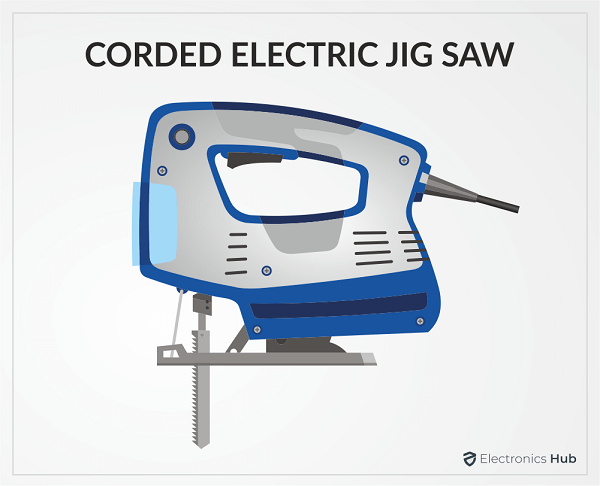
Most commercial and heavy-duty Jigsaws are available as corded electric. Just plug the cord into a standard electrical outlet and use the Jigsaw for continuous operation.
The electric motors in these types of jigsaws are very robust and can withstand long working hours. You can get a wide range of power ratings with corded electric Jigsaws starting with 400 Watts to more than 1,000 Watts.
Coming to the cost of Corded Electric Jigsaws, you can get a good quality tool from reputed brands for as little as $40 (120V, 5A variant).
Overall, corded electric Jigsaws are very reliable tools with very good performance, low cost, and suitable for longer operations.
Cordless Electric
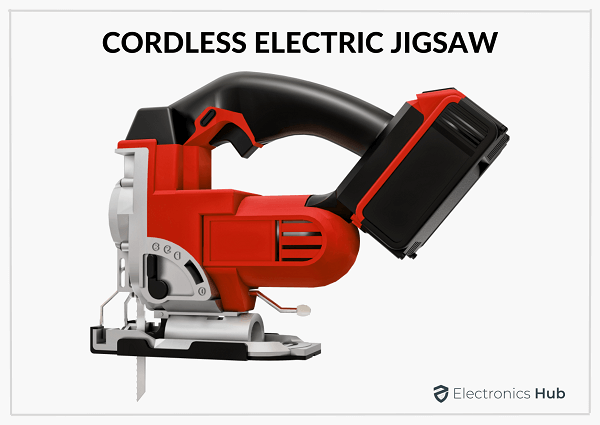
Almost all popular brands have cordless jigsaws in their catalog. Newer and less popular brands have a relatively low starting price of $45. But cordless jigsaws from reliable brands also start at $60. You can get even more powerful cordless jigsaws that cost more than $130.
The main advantage of using a cordless jigsaw is well, they don’t need any wires to provide the power. Just insert a fully-charged battery into the tool and start using it.
As there is no power cord, cordless jigsaws give you the benefit of ultra-portability as well as the ability to use in tight or difficult-to-reach places.
The battery voltage ratings of cordless jigsaws start from 12V and can go all the way to 36V. 18V and 20V ratings are very common.
Due to the battery pack, cordless jigsaws tend to be slightly heavier than their corded counterparts. But as the price gap is becoming narrow, several professionals and DIYers are choosing battery-operated jigsaws over corded electric ones.
Pneumatic
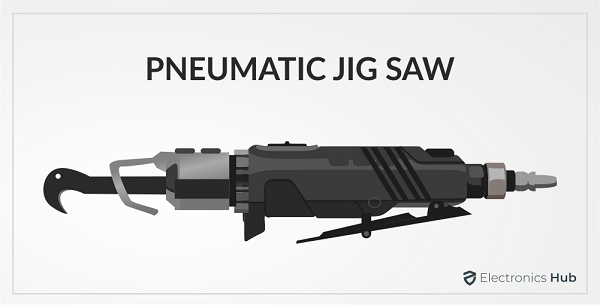
As pneumatic Jigsaws use compressed air to power the “motor”, they run relatively cooler due to the airflow. Also, these tools are very lightweight.
You can find pneumatic jigsaws in high-end professional jobs that need some heavy-duty cutting of tough materials.
Based on Reciprocating Action
Straight Reciprocating
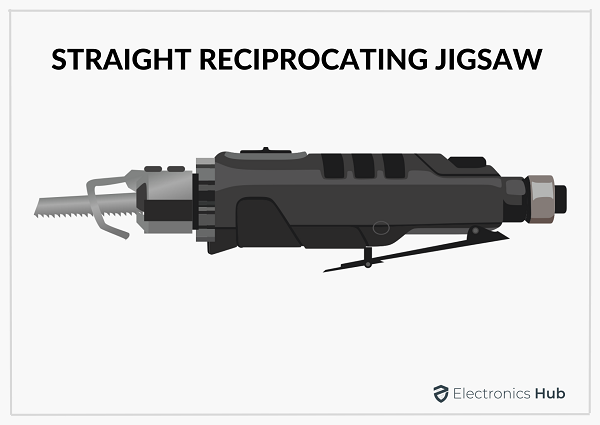
As a result, the cutting actions become slow. But the advantage of Straight Reciprocating Jigsaws is that they are very good for tracking a curve or making turns on the material.
Orbital Reciprocating
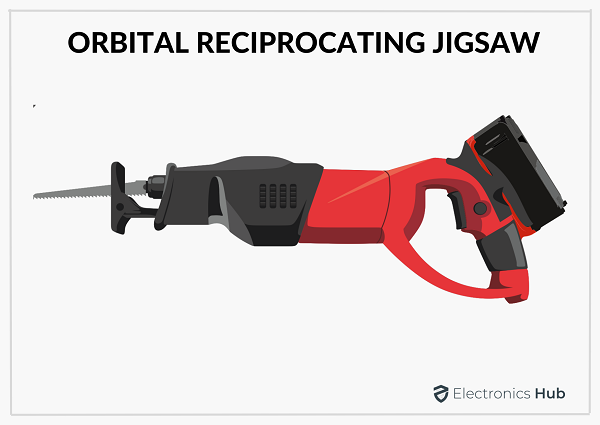
But for curved or turns, this type of motion is not useful. So, most modern jigsaws that are of orbital reciprocating type have a setting switch that controls the level of orbital action. A higher setting is suitable for straight cuts while a lower setting is suitable for curved cuts.
Based on Grip Style
Top Handle
The traditional grip style is the top handle grip. In this type, the Jigsaw has a large “D” shaped handle with a finger trigger inside the loop. This grip is easy on hands but as our hand lies at a higher stance, it becomes slightly difficult to operate. Also, the accuracy is slightly on the lower side.
Barrel Grip
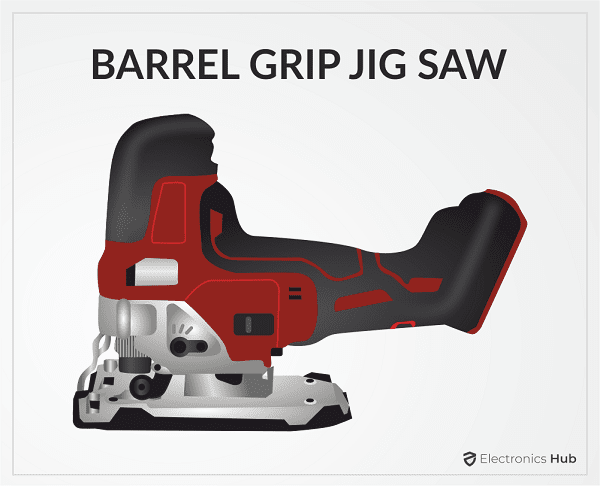
The cutting accuracy with barrel grip is much higher and also the trigger is usually a thumb switch instead of a finger switch.
A Brief Note on Jigsaw Blades
An interesting part about the Jigsaw is its blade. Modern Jigsaw blades have a “T” shape top (a T-shank) so that it easily locks into the reciprocating mechanism without the need for any tool to install it.
The other type of blade option is a Universal Blade or a U-shank that requires a special tool to change the blade from the saw mechanism. These blades are becoming rare day by day as the tool-less T-Shank blade is a popular choice.
Jigsaw Blades have two main characteristics. One is the number of teeth per inch. The other is the direction of the teeth. Depending on these factors, you can get various types of Jigsaw blades.
Apart from the characteristics that we mentioned above, the material of the Jigsaw blade is also important when choosing one. The material decides the durability, stability, and suitability of the Jigsaw for application.
Different Jigsaw Blade Materials
Here is a list of some popular Jigsaw blade materials.
- High-speed Steel Blades
- Carbon Steel Blades
- Bi-metal Blades
- Tungsten Carbide Blades
High-speed Steel Blades
One of the basic blade materials is Steel. It is inexpensive but has an excellent performance with high durability and good resistance to heat. You can use these blades on all materials such as wood, metal, and plastic.
Carbon Steel Blades
The carbon steel blades have a high percentage of carbon. As a result, these blades are significantly stronger than regular steel blades.
As the material of the blade is essentially steel (with carbon), these blades are quite flexible and also become dull very easily. You can use these blades on different types of wood-cutting jobs.
Bi-metal Blades
As the name suggests, these blades have a combination of two metals, usually carbon steel and high-speed steel. The bi-metallic nature of these blades makes them slightly more flexible. They also do not become dull very soon.
Tungsten Carbide Blades
The final blade material on the list is tungsten carbide. These are very durable and often very expensive. Due to tungsten, these blades have very high heat resistance. So, you can use these blades to cut tiles, steel, and other tough materials.
Conclusion
Jigsaw is a versatile power tool that can make straight cuts in lumber or curved cuts in wood, metal, or plastic. In this guide, we saw the basics of Jigsaw and also different types of Jigsaws.
After that, we saw some important information regarding Jigsaw blades.

